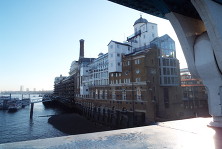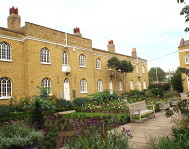








Goose Green and St John the Evangelist
Goose Green at the northernmost part of East Dulwich is a welcome green space within a built up area with plane trees around the perimeter that have grown very tall. Still retaining the feel of a village green, it is probably the oldest and most historic surviving location in East Dulwich. It was purchased in 1868 by Camberwell Vestry at the same time as Peckham Rye Common to save it from development.
Formerly common land where the poor grazed the small amount of live stock they owned, it was named after the geese once kept there. Though once a part of Peckham Rye Common, Rocque’s map of 1766 shows it as a separate area, already with its own identity.
Walter Besant, writing in 1899 of a time already gone by, remembers that ponies were kept for hire on Goose Green and were ridden up and down the hill by local boys. Until the middle of the 19th century, there were only a few cottages surrounding the Green. Plaget Hall Farm was to the north east, the farm house located where St John the Evangelist’s vicarage is today. The South London Chronicle of 6 August 1864 describes a waymarking stone in the south west corner, one and half feet high by 8 inches square, that was inscribed on one side “The site of the Manor Pound removed 1860” and on the reverse “Camberwell Friern Manor 1860”.
East Dulwich and the surrounding areas were now being developed, streets of houses were beginning to be built, and the population was growing. A map dated 1870 (below) shows the new St John the Evangelist Church and the vicarage, Walnut Tree Villa, built on the site of the old farmhouse. To the east of Goose Green there was now a large house called East Dulwich House in a large, laid out garden and to the south more houses had been built including Norland House, also with a large garden.
At the beginning of the 19th century, East Dulwich was within the parish of St Giles Camberwell. With a growing population, Thomas Baily, a large land-owner in the area, paid for the building of the East Dulwich Chapel to save people the journey over the hill into Camberwell to attend service on a Sunday. This chapel was located to the south west of Goose Green roughly on the southern corner of Tintagel Crescent. Still the population grew and by 1861 the Chapel was unable to accommodate the expanding congregation. It was hoped to enlarge the existing Chapel but it was not possible to acquire the necessary surrounding land. A donation of land was made by the Lord Chief Justice Charles Jasper Selwyn who owned land to the north of Goose Green for the site of the present church. Subscriptions were raised for the building of the church, mainly from the better off but the poor contributed as well. St John the Evangelist was consecrated by the Bishop of Winchester on 16 May 1865 and was able to seat a congregation of 845. The architect for the new church was Charles Baily, son of Thomas Baily, and designed in the gothic style. WH Blanch describes the church as reminiscent “of some of those antique village churches of which, in these days of rapid railway travelling, we catch a brief glimpse on many a picturesque spot in Surrey, Sussex, or Kent.”
To the left, Goose Green in 1870 and right in 1894
The railway arrived in East Dulwich in 1868 when the station, originally called Champion Hill station, made rapid travel into London even easier and more people found East Dulwich attractive as a place to live. The pace of building increased rapidly – compare the maps above – and any illusion of Goose Green and St John’s as rustic quickly disappeared.
In Victorian times, Goose Green was the centre for children’s and sports events, and the community emphasis continues today. It is home to the annual Dulwich Festival Fair, school fetes and carol singing, and a popular spot for dog-walking and sun-bathing. It has a recently renovated playground to the east and a newly introduced wildflower area. It was awarded a Green Flag in 2015.
More on the history of St John the Evangelist
Web discoveries
- UK Casino Not On Gamstop
- UK Casino Not On Gamstop
- Non Gamstop Casino
- Casinos Not On Gamstop
- Non Gamstop Casinos
- Non Gamstop Casinos
- Non Gamstop Casino
- Casino Sites Not On Gamstop
- Slots Not On Gamstop
- Casinos Not On Gamstop
- UK Betting Sites Not On Gamstop
- UK Casino Not On Gamstop
- Best Non Gamstop Casinos
- Betting Sites
- Non Gamstop Casino Sites UK
- Best Non Gamstop Casinos
- Non Gamstop Casino
- Casinos Not On Gamstop
- Non Gamstop Casino Sites UK